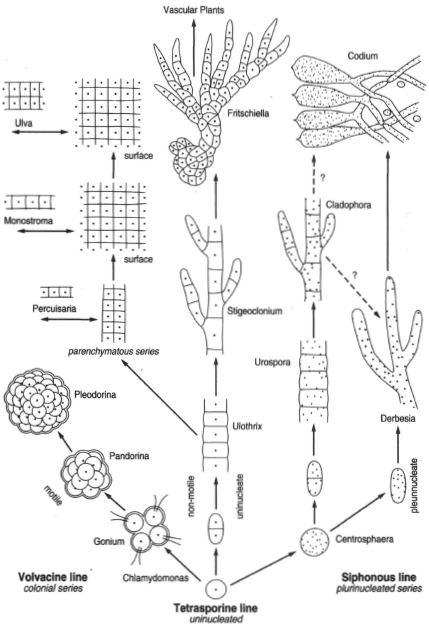The Green Algae
There are more than 20,000 species of green algae. All are & Notes & eukaryotic, possessing definite nuclei. All contain the pigments chlorophyll a, chlorophyll b, carotenes, and xanthophylls-the same pigments that occur in flowering plants. In addition to well-defined nuclei, all possess the other organelles found in eukaryotic cells: nucleoli, vacuoles, ribosomes, mitochondria, endoplasmic reticulum, and chloroplasts. Genus can sometimes be recognized by the shape of chloroplasts. The product of photosynthesis is starch similar to that found in higher plants. Both motile and nonmotile forms occur, and both sexual and asexual reproduction take place. The motile forms have whiplash-type flagella and are of equal length. Some forms grow on snow and ice, some on the trunks of trees; in protozoans, hydra, flatworms, animal fur, and sponges; or on the backs of turtles. Green algae grow as symbionts in the formation of lichens. Most green algae are found in fresh water.A generally accepted way of classifying green algae is to group them according to three presumed lines of evolution. The first its the Volvacine line, encompassing flagellated, unicellular or colonial forms; the second is the Tetrasporine line, encompassing nonmotile cells in filaments or sheets: and the third is the Siphonous line, characterized by a plurinucleated plant body and generally absent cross walls.
While these lines of evolution are based on considered thought, it is important to note that they are theoretical and, thus, not cast in stone. Revisions to this theory, then, may be forthcoming.
 |
| Figure 13-1 Three postulated lines of evolution of the green algae: the Volvacine line, encompassing flagellated unicellular or colonial forms; the Tetrasporine line, encompassing nonmotile, uninucleated forms; and the Siphonous line, encompassing plurinucleated forms. |




